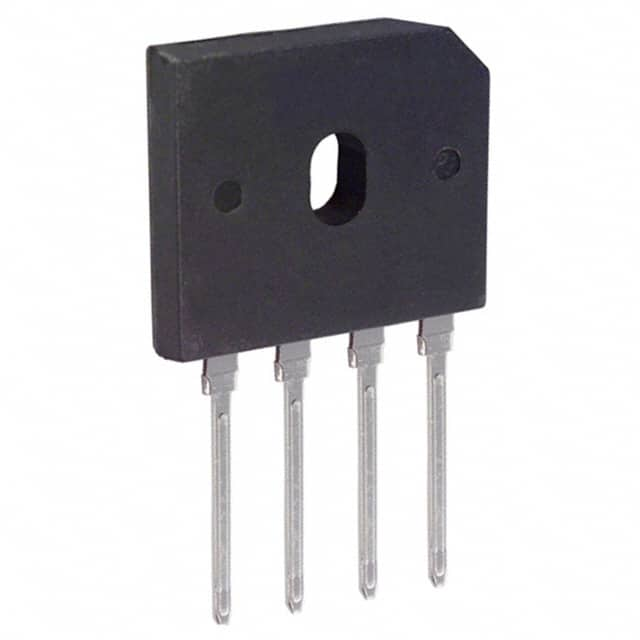GBU10005 Product Overview
Introduction
The GBU10005 is a crucial component in the field of electrical engineering, belonging to the category of bridge rectifiers. This versatile product is widely used in various applications due to its unique characteristics and functional features.
Basic Information Overview
- Category: Bridge Rectifier
- Use: Converting AC voltage to DC voltage
- Characteristics: High efficiency, compact design, reliable performance
- Package: Standard diode package
- Essence: Essential for converting alternating current (AC) to direct current (DC)
- Packaging/Quantity: Typically available in reels or trays containing multiple units
Specifications
- Maximum Average Forward Current: 10A
- Peak Repetitive Reverse Voltage: 50V to 1000V
- Maximum RMS Voltage: 35V to 700V
- Operating Temperature Range: -55°C to +150°C
- Storage Temperature Range: -55°C to +150°C
Detailed Pin Configuration
The GBU10005 bridge rectifier typically consists of four pins arranged in a specific configuration to facilitate its integration into electronic circuits. The pinout configuration includes the input and output terminals, ensuring proper connectivity and functionality.
Functional Features
- Efficient conversion of AC to DC voltage
- Compact design for space-saving integration
- Reliable performance under varying load conditions
- Low power dissipation for energy-efficient operation
Advantages and Disadvantages
Advantages
- High efficiency in converting AC to DC
- Compact size for easy integration
- Reliable performance in diverse applications
- Low power dissipation for energy savings
Disadvantages
- Limited maximum average forward current compared to higher-rated bridge rectifiers
- Narrow peak repetitive reverse voltage range for certain applications
Working Principles
The GBU10005 operates on the principle of rectification, where it converts the alternating current (AC) input into a pulsating direct current (DC) output. This process involves the use of diodes arranged in a bridge configuration to ensure unidirectional flow of current, resulting in a smooth DC output.
Detailed Application Field Plans
The GBU10005 finds extensive application across various industries and electronic systems, including: - Power supplies - Industrial automation - Motor drives - Consumer electronics - Renewable energy systems
Detailed and Complete Alternative Models
For users seeking alternative bridge rectifiers with similar functionalities, the following models can be considered: 1. GBU1004 2. GBU1006 3. GBU1008 4. GBU1010
In conclusion, the GBU10005 bridge rectifier offers a reliable and efficient solution for converting AC to DC voltage in diverse electronic applications. Its compact design, high efficiency, and reliable performance make it a valuable component in the field of electrical engineering.
Word Count: 410
רשום 10 שאלות ותשובות נפוצות הקשורות ליישום של GBU10005 בפתרונות טכניים
Sure, here are 10 common questions and answers related to the application of GBU10005 in technical solutions:
What is GBU10005?
- GBU10005 is a bridge rectifier component commonly used in electronic circuits to convert alternating current (AC) to direct current (DC).
What are the typical applications of GBU10005?
- GBU10005 is commonly used in power supplies, motor control, and other industrial and consumer electronics applications that require AC to DC conversion.
What is the maximum voltage and current rating for GBU10005?
- The maximum voltage rating for GBU10005 is typically 1000 volts, and the maximum current rating is usually around 10 amps.
How does GBU10005 compare to other bridge rectifiers?
- GBU10005 offers a high voltage and current rating, making it suitable for medium to high power applications. It also has a compact package design for easy integration into circuit boards.
What are the key features of GBU10005?
- Some key features of GBU10005 include its high surge capability, low forward voltage drop, and high isolation voltage.
Can GBU10005 be used in automotive applications?
- Yes, GBU10005 can be used in automotive applications where AC to DC conversion is required, such as in vehicle charging systems and motor control units.
What are the thermal considerations when using GBU10005?
- It's important to consider heat dissipation and thermal management when using GBU10005, especially in high-power applications, to ensure proper performance and reliability.
Are there any recommended layout guidelines for integrating GBU10005 into a circuit?
- Yes, it's recommended to follow the manufacturer's layout guidelines to minimize parasitic effects and optimize the performance of GBU10005 in a circuit.
Can GBU10005 be used in three-phase rectification applications?
- Yes, GBU10005 can be used in three-phase rectification setups by configuring multiple bridge rectifiers to handle each phase of the input power.
What are the potential failure modes of GBU10005 and how can they be mitigated?
- Potential failure modes include overvoltage, overcurrent, and thermal stress. These can be mitigated by implementing appropriate protection circuits, current limiting, and thermal management measures.
I hope these questions and answers provide a good overview of the application of GBU10005 in technical solutions. Let me know if you need further information on any specific aspect!


